This first table shows the Nemesis 360GTS’ Watts/10 Delta Temp numbers in a quick glance chart format.
Using the data compiled from the Nemesis GTS thermal testing I have compiled the following tables in an attempt to show another way how the GTS performance varies against itself at the flow rates and fan speeds tested. Effectively these show percentage gains relative to a reference point. It’s an interesting way to show gains/losses while changing a variable.
First let’s focus on 1300 RPM as our reference and see how much gain or loss in performance we get by changing fan speed.
Neutral tones here indicate the 360GTS is tuned for best performance somewhere around this 1300rpm fan speed range. In the next plot we focus on changing the flow rate with 1.0 GPM as the base line.
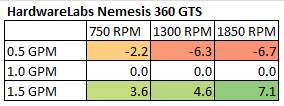 In this we see similar percentile gains and losses so we conclude that the 360GTS is very well tuned to be able to perform well at all flow rates.
In this we see similar percentile gains and losses so we conclude that the 360GTS is very well tuned to be able to perform well at all flow rates.
Lastly, we change the reference and choose our center 1300 RPM and 1.0 GPM as our reference point to show both effects concurrently:
So from the data above we can get a very good idea of how the Nemesis GTS radiator performs relative to itself. But there is a large selection of 360mm radiator models to choose from, released from numerous manufacturers. So, we need to start comparing performance between them.
Push Only Data vs Competition
Let’s focus on the Push Only results for now and come back to the Push/Pull data later. While for Push/Pull we tested three flow rates, the Push Only testing was conducted only at 1GPM in order to save time. For a comparison vs thicker radiators make sure to check out the 2015 Rad Round Up which compares 27+ radiators including the SE.
Let’s start with 750 RPM and see how it compares to the competition:
At 750RPM the GTS performance is excellent, have a clear performance advantage over the rest.
How does the GTS360 perform with 1300 rpm fans.
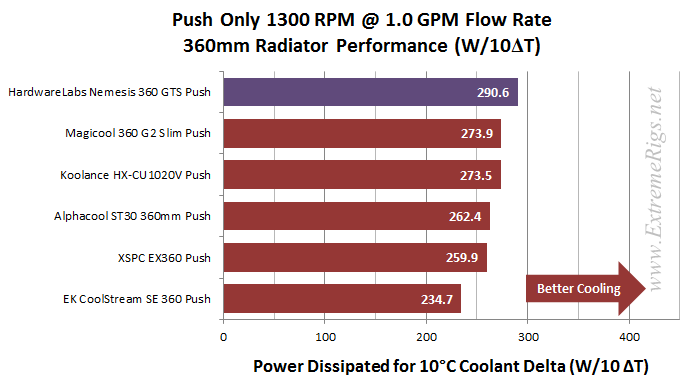 At 1300 RPM it still has a clear advantage over the rest of the field.
At 1300 RPM it still has a clear advantage over the rest of the field.
And at 1850 RPM…
At 1850RPM the still has great performance for a slim rad, but we see the very high FPI Koolance rad outperforming everything else.
So the 360GTS was a fantastic performer in Push Only. The fan speeds made little difference to its comparisons against the competition and only the brute force nature of the Koolance design saw the GTS taking a clean sweep. We would expect the same comparison trends to continue in Push/Pull.
Let’s find out how it fared…..
Push/Pull Data vs. Competition
Let’s now look at the Push/Pull results and see how the 360GTS compares. For Push/Pull we have averaged the results from the 3 flow rates at which we tested.
At 750RPM the 360GTS continues to dominate the middle pack, which all have very similar results.
At 1300 RPM Push/Pull.
Things do change here with the Koolance taking over the lead and has a 5% advantage over the 360GTS.
1850 RPM and again the 360GTS takes second place, just holding off the rads behind it, while falling a bit further behind the winner with a 10% gap between the two.
Let’s also combine the Push Only and Push/Pull results at the 1.0 GPM flow rate into one plot for each fan speed tested. These plots show just how well the best slim radiators performed against the competition, while clearly showing the SE’s lack of performance.
Again the 750 rpm first:
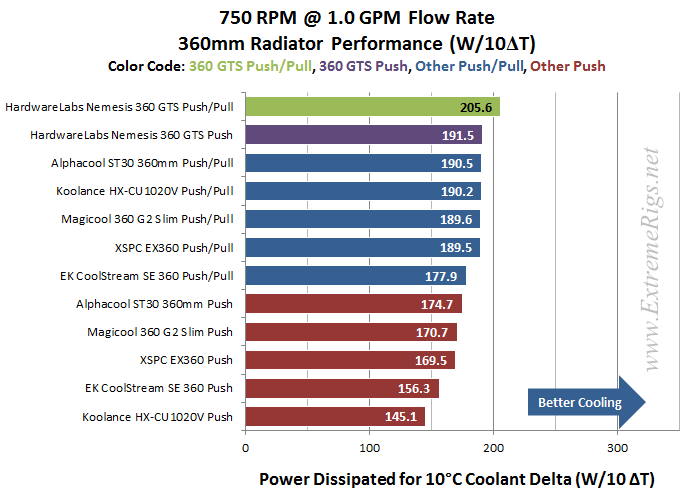 What an amazing performance with the 360GTS taking 1st and 2nd place. Think about that for a second, the 360GTS’ Push Only results beat all other Push/Pull results – that is almost unbelievable, but that is exactly how the results ended up.
What an amazing performance with the 360GTS taking 1st and 2nd place. Think about that for a second, the 360GTS’ Push Only results beat all other Push/Pull results – that is almost unbelievable, but that is exactly how the results ended up.
1300 RPM Combined
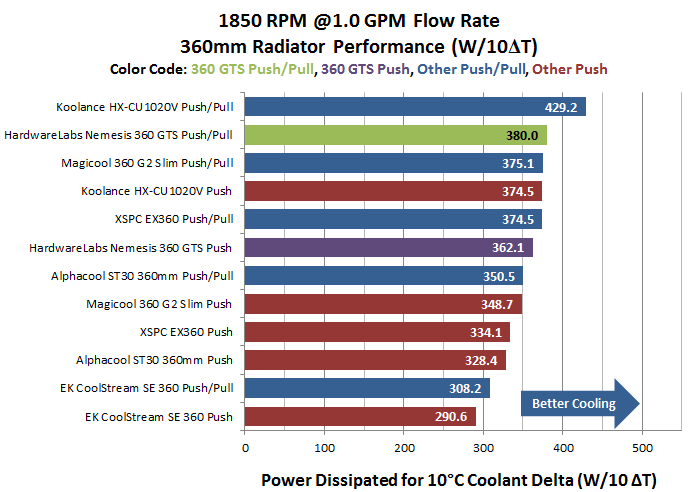 The 360GTS’ performance is still excellent at 1850 RPM, but we can see the Koolance is dominating the field.
The 360GTS’ performance is still excellent at 1850 RPM, but we can see the Koolance is dominating the field.
From all of these results we created a “Performance Factor” ranking system. The radiator with the best cooling ability (W/10ΔT) at each gpm/rpm combo was awarded a score of 100, and each other radiators W/10ΔT result was scored as percentage of the top performer:
This way of looking at the comparison takes away any advantages that a radiator may have at higher or lower fan speeds and looks at an overall average. While this appears fair it does tend to favor those radiators that are all-rounders and those radiators which do very well at high RPM. Most users should be more focused on their specific use case. Check in the Round Up for performance comparisons at every gpm/rpm combo for even more details and cross comparison results.
Here is the 360GTS’ Push/Pull percentage scores at each data point that thermal tests were conducted at and additionally the 1.0 gpm Push Only percentages relative to the winner at each fan speed.
Looking at the results this way we can see how the 360GTS dominated the low fan speed / low pressure tests with 5 out of 6 1st places in the Push Only and low fan speed Push/Pull results.
Then we started averaging the percentage scores at each flow rate giving us the Averaged Performance Factors of each radiator.
Firstly – the Push Only APF:
The 360GTS Push Only results were outstanding and was a clear winner !!
Now the Push/Pull APF:
 The Push/Pull APF win was taken by tyhe Koolance and it’s very high FPI core structure. The 360GTS places a very respectable 2nd place with a clear performance edge over those behind it.
The Push/Pull APF win was taken by tyhe Koolance and it’s very high FPI core structure. The 360GTS places a very respectable 2nd place with a clear performance edge over those behind it.
Finally we created the Master Performance Factor which is calculated from the averaged results of all the thermal tests, Push and Push/Pull at all flow rates and all fan speeds.
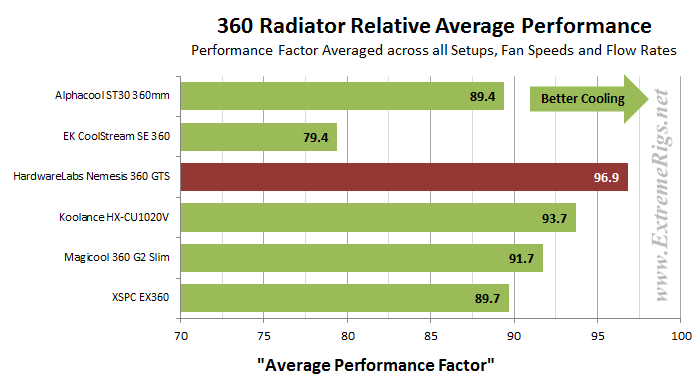 With its excellent results in all the thermal test the 360GTS is a clear winner in the Master Performance Factor and takes the best overall rad of the 360mm slim rads in the test group.
With its excellent results in all the thermal test the 360GTS is a clear winner in the Master Performance Factor and takes the best overall rad of the 360mm slim rads in the test group.
Next up – Summary!







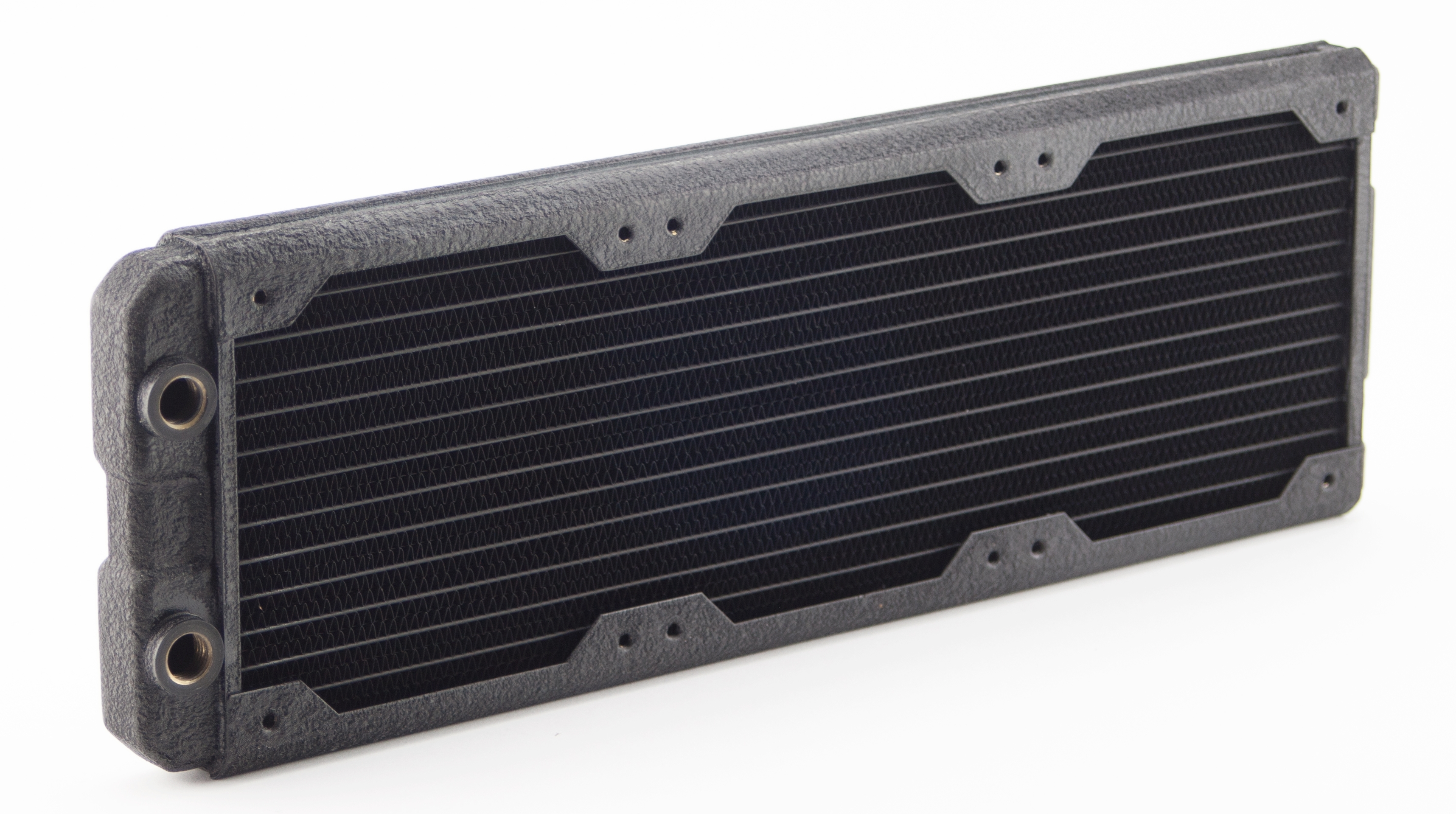
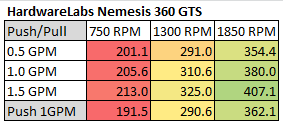
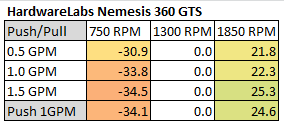
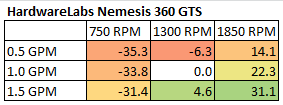
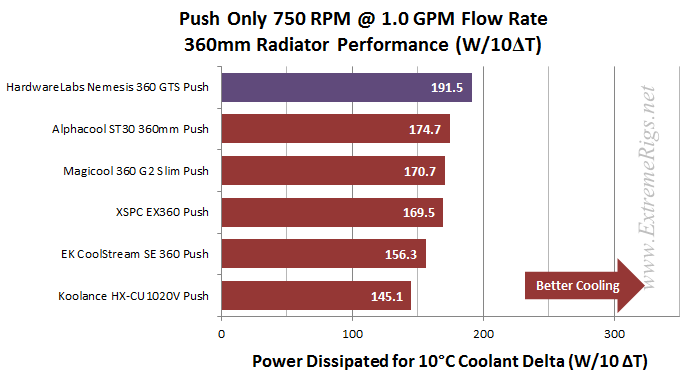
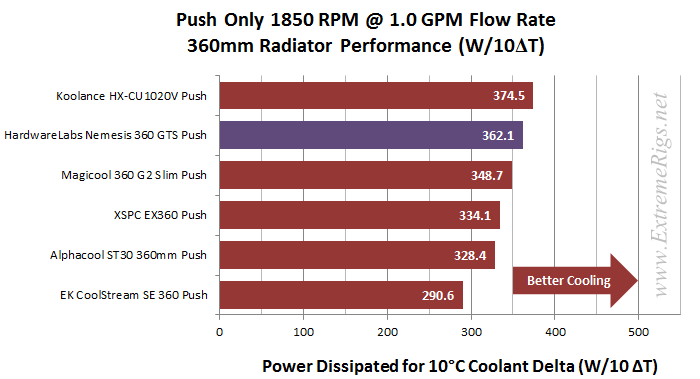

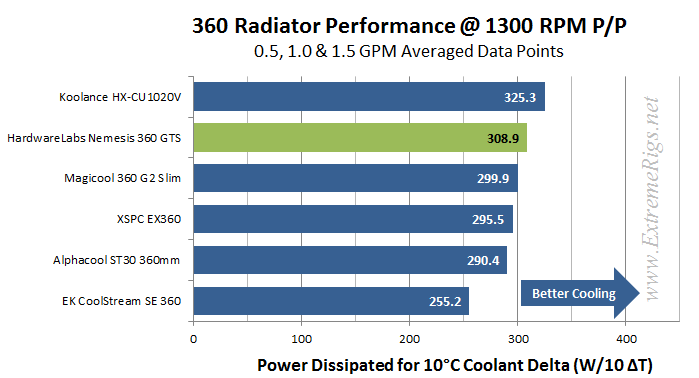
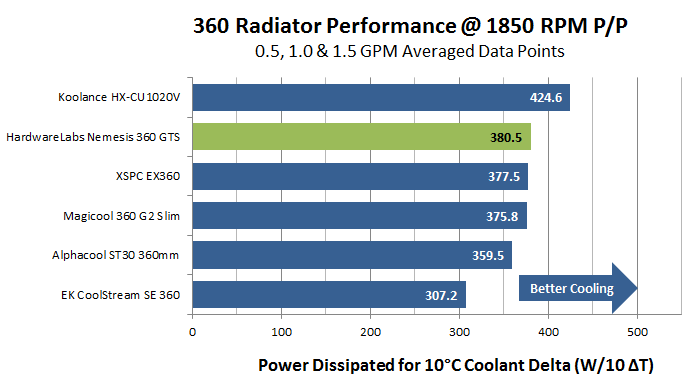
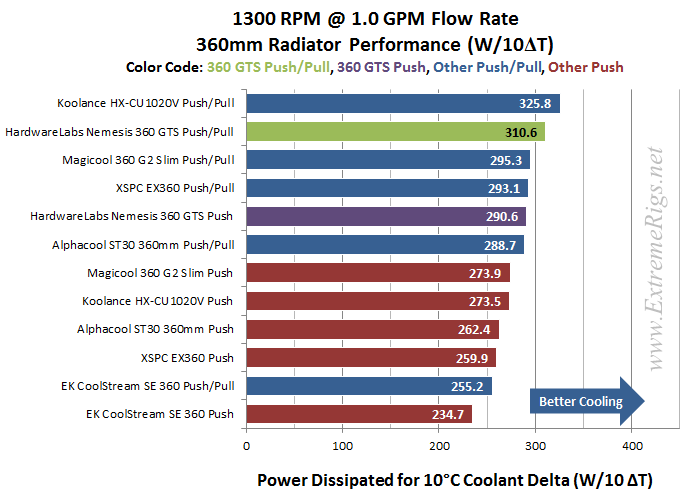
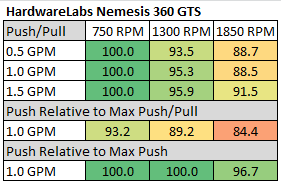
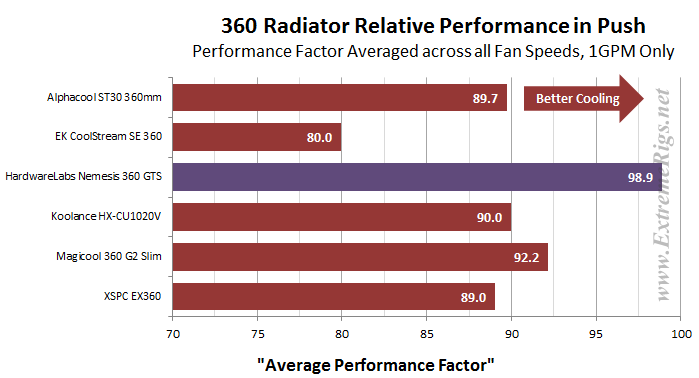




[…] Radiator Coolgate G2 360 Radiator EK PE 360 Radiator Hardware Labs Alpha Extreme III 360 Radiator Hardware Labs Nemesis GTS 360 Radiator Hardware Labs Nemesis GTX 360 Radiator Hardware Labs SR-1 360 Radiator Koolance HX-360XC 360 […]
I wish they did multi port versions of the Nemesis GTS. That would be the logical next design evolution for HWLabs.
What are the implications for using a highly restrictive rad like the 360gts? Does it play nice with other rads in a multi rad cpu/gpu cooled rig?
thanks
Hi David,
This is a great question, that is rather complicated to answer, as so much of the detail is reliant on the other components in you water cooling loop.
I’ll try to make the answer as simple as possible to understand, even if some the terminology isn’t technically correct.
So…
Let’s start back with the pump/s & pump top set up (which I’ll just call pump) that one may be using as it is the heart of any water cooling system.
The pump has a maximum amount of “power” with which it is able to move the coolant.
The maximum “power” has 2 dynamically linked properties which we call “Flow Rate” and “Pressure”
As one of these properties goes up, then the other must come down, because the pump has a limit on it’s (maximum) “power”
So let’s imagine that the pump is set up in a loop all of it’s own, with no other components.
The flow rate will be very high because the restriction level is low and the none of the pump’s “power/pressure” is needed to overcome any restrictions.
Now – if we start adding in components such as blocks and radiators we are placing restrictions the pump must overcome.
To do this the pump’s “power” is dynamically changed depending on the restriction level of the components.
More restriction = is more pressure needed by the the pump to get the coolant through the block/radiator….
which results in a lower flow rate.
So with a restrictive radiator like the 360GTS it will play nicely with other components in the loop.
The question is, does your pump have enough “power” to achieve a flow rate you desire after using up “pressure” on the components.
If nothing else, that should get you thinking 🙂
wow, perfect explaination.
Wonder if anyone knows how much the 360 GTS Nemesis weighs in grams? I almost replaced it with the Coolgate 360HD as the specs seemed better but when I held both in my hands it seemed liked the Nemesis GTS 360 was heavier as in better materials and more copper and had just as much radiator height internally though the 360hd had a taller casing and weighed 790g. Could not find wieght info published online anywhere. Mine is the X-Flow version however. Thanks
[…] reviewed the regular Nemesis 360 GTS for the Extreme Rigs Rad Round Up 2015, and we have also featured it’s data in some reviews which […]
[…] offering from HWLabs and is the thinnest of the 140 rads that we’ll be looking at. The Nemesis 360 GTS really surprised us in the 360 roundup as it was competitive with larger radiators despite […]
[…] we reviewed the Nemesis 360 GTS last year, we may make a comparison or two between the 280 and 360 variants. The 280mm version only […]
Thanks for the excellent review. I really can’t figure out if this rad is for me though?? I will be using x2 360 rads to cool a 5820K+1080 GPU, using lower RPM fan speeds, but the flow restriction issue has me concerned. The Alphacool Nexxxos ST30 360 seems VERY close in performance, but with better flow restriction. Really don’t know which one to go for?! I have an EK-XRES 140 Revo D5 PWM pump/res.
I’m in the same situation as you…..
I also have the Ek X-Res 140 Revo D5 and also like to know what’s the better 360m slim rad at the moment?
Will the Nemesis GTS 360 work ok with this pump? I will only have the an EK block for the cpu in my loop.
Thanks.
A D5 puts out about 4.5 PSI at 1GPM, let’s assume 1 PSI for your cpu block and 0.5 PSI for your gpu block. 1 Nemesis GTS rad is ~1 PSI at 1GPM. So that’s a total of 3.5PSI at 1GPM which is well within reach of a D5 🙂 So yes the GTS will be fine. It’s more of a problem if you’re going to be using 3-4 as well as multiple gpu blocks and a weaker pump 🙂
What about pump like Magicool DCP450?
Im planing to use Alphacool Eisblock XFX – its very restrictive
2x Nemesis GTS 240mm – again… very restrictive
and single GPU full cover block.
Comments are closed.